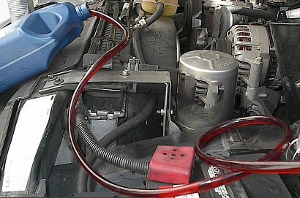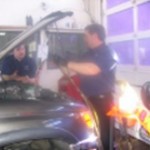Have you ever brought your car in for something simple – an oil change – and the mechanic approaches you with a list of potential parts and services it needs to run properly?
It can be confusing at best.
Does your car need fluid flushes or full detailing to ensure an efficient ride? Or is this just a way for the mechanic to bring in extra money?
We get it. It seems as if every company is fighting for ways to add on sales, and bring in extra money.
And flushes can be confusing. Let’s take a power steering flush as an example. You know your car uses power steering to make it easy to drive. You may have a general understanding of mechanics, knowing it takes power steering fluid to ensure movement as you go. How does the fluid get there? And will it wear down? How do you know?
Great questions! Let’s find out.
Start with understanding the power steering system
Power steering is a system that uses engine power to control the front wheels effortlessly. It makes it easy to maneuver at lower speeds, making it easy to take tight corners, and turn into spaces like parking spots and enter garages. Without it, you’d need a lot more force to keep control over your vehicle, especially as you turn and move in different directions.
Today’s vehicles use one of three power steering systems: hydraulic, electric, or hybrid electro-hydraulic. Each utilizes the same function, even if they approach it differently.
The oldest – hydraulic power steering – has been assisting drivers for more than 50 years. It utilizes a hydraulic pump assembly that pushes transmission fluid into the steering assembly, which aids in controlling the tires. The pump draws power from the engine to perform its work. Because it remains operational while the vehicle is running, it exerts wasted energy while moving on a straight stretch of road.
Hydraulic power steering relies on several different types of power steering fluid.
- Automatic transmission fluid (ATF)
- Synthetic power steering fluid – these are engineered for specific types of cars
- Non-synthetic power steering fluid – mineral fluid that often is used in place of ATF
Like other fluid types, it’s important to know which your car accepts to reduce the chance of damage, and give your car what it was designed with.
Electric power steering (EPS) is becoming the new norm for today’s vehicles. Instead of a hydraulic pump, the gear connects to an electric motor and a control module, which uses sensors to determine how much assistance is needed to the steering system while you drive.
Electro-Hydraulic steering is a hybrid of the two. It provides the smooth feel of a hydraulic system, with the energy draw of the electric system. It improves fuel economy as the pump only operates when you need assistance. This is most common in heavy commercial vehicles, though some car manufacturers install them because of the benefits.
My car uses power steering fluid – do I need a flush?
If you use hydraulic power steering fluid, you may wish to speak with a mechanic about the benefits of having the steering pump flushed and filled with fresh fluid. It pays to know what your manufacturer suggests, as well as understand what your mechanic finds to make this suggestion.
While it isn’t a common maintenance item, it isn’t something you can ignore. Paying attention to what’s happening under the hood can give you assurance everything is in good working condition.
Power steering fluid is red, and is often similar in color to coolant (if your coolant is red.) It can turn a deeper shade over time. Color alone isn’t a sign that something is wrong. It takes further investigation.
If you notice a leak, find out where it’s coming from. Over time, seals, o-rings, and other parts can deteriorate and result in a leak. Fluid underneath your car in conjunction with problems with your power steering could be an indicator it’s time for a power steering flush and repair work.
Many reservoirs are installed with see-through plastic so you can track how much fluid you have, and check to ensure it’s not running low. Your owner’s manual will guide you to where it’s located on your vehicle.
What a power steering flush will do for your vehicle
Is a power steering flush really needed? There are a few important things this service can provide you with.
- Better steering – if you notice your driving is becoming more difficult, it may be a sign of compromised power steering fluid. New fluid will get rid of the grime, and make your drive that much safer.
- Protects the pump – fluid is the life-blood to any major component. Replacing power steering fluid is much less expensive than risking damage to larger items like the power steering pump.
- It flushes harmful contaminants – driving here in Colorado means you’re subjected to everything on the road. Mag-chloride and salt in the winter, mud and other debris in the summer as the rains set in. flushing the system pushes these harmful contaminants out.
- Peace of mind – keeping the maintenance items recommended in your owner’s manual on your calendar can give you peace of mind over time. Instead of waiting for a major breakdown, being proactive can keep your vehicle in the best working condition possible.
Is it time for a power steering flush?
Before you head out on your next road trip, or move into a new season, head in for an inspection to keep your vehicle operating well.
By working with our mechanics, we can help you determine how to keep your car in good working condition.
Schedule your visit today.



